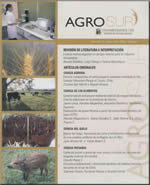TECHNICAL AND ECONOMIC FEASIBILITY OF PASTURE IRRIGATION FOR MILK PRODUCTION, IN SOUTHERN CHILE
Main Article Content
Abstract
There are several manners that can be used to increase pasture production, one of which is irrigating during dry periods. It is important to generate information regarding the technical and economic feasibility of investment in equipment for pasture sprinkler irrigation in southern Chile. A total of 60 irrigation projects were carried out, using different combinations of factors involved, such as: different irrigation equipments (quick coupling pipes, hose rewinding drum, central pivot and K-Line); energy sources (gravimetric energy, electricity and oil); water sources (superficial and groundwater); irrigated surface areas (10 and 25 ha) and partial project financing through Law 18.450 (0 and 50% irrigation subsidy). For each project, technical and economic aspects were calculated, analyzing investment and annual costs per hectare. The results showed that the central pivot was the system that required the lowest water flow for the application of the irrigation rate; on the contrary, quick coupling systems used the greatest water flow. In terms of the investment costs, K-Line systems showed the lowest and those of the central pivot were the more expensive. Regarding energy sources, systems with a water fall (gravity) and diesel operation required the lowest investment, whereas electrically powered systems were the most expensive. In general, projects without an irrigation subsidy (Law 18.450) were not economically profitable (for 10 and 25 ha), except for the K-Line projects (10 and 25 ha) and quick coupling projects (10 and 25 ha). On the other hand, some 25 ha subsidized irrigation projects were economically attractive, being outstanding K-Line and central pivot systems, which presented the greatest marginal income of this study, reaching $173.229 ha-1. Systems that used underground water had a negative income, even when they were subsidized.

